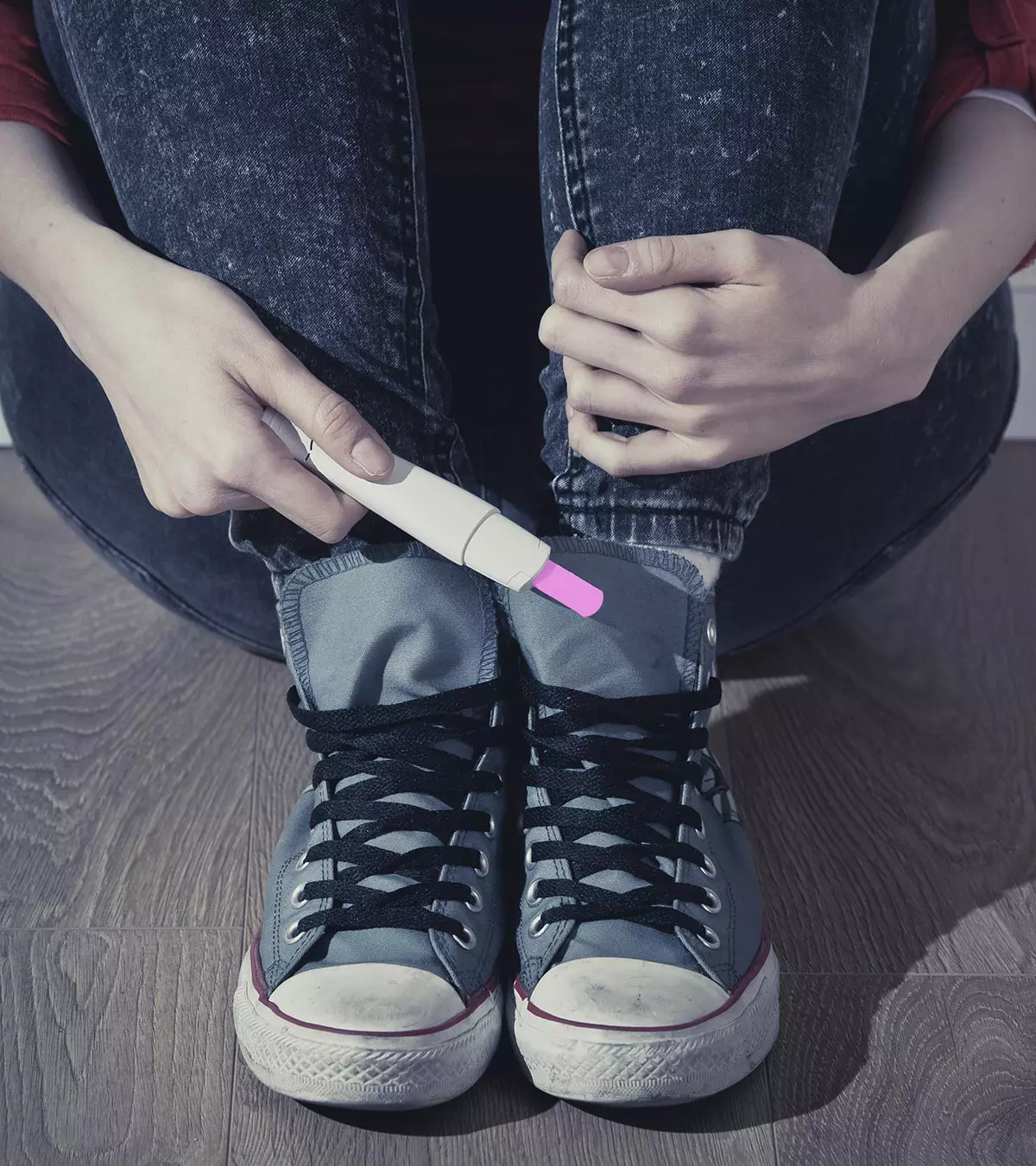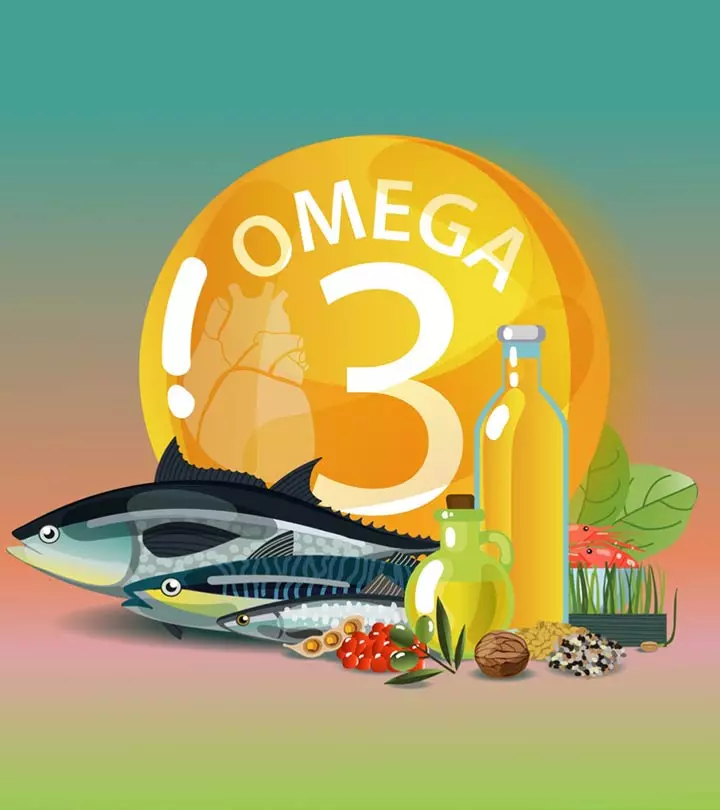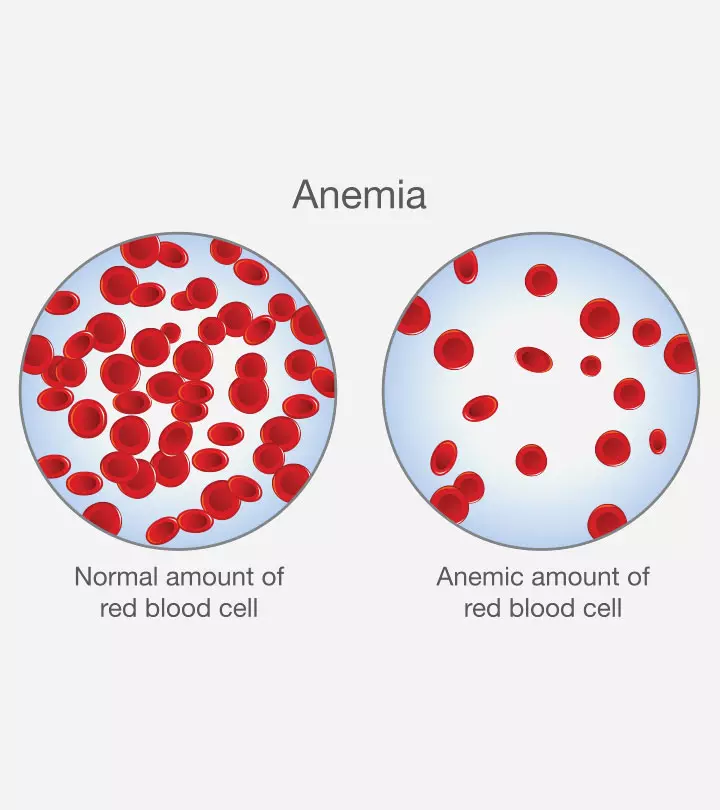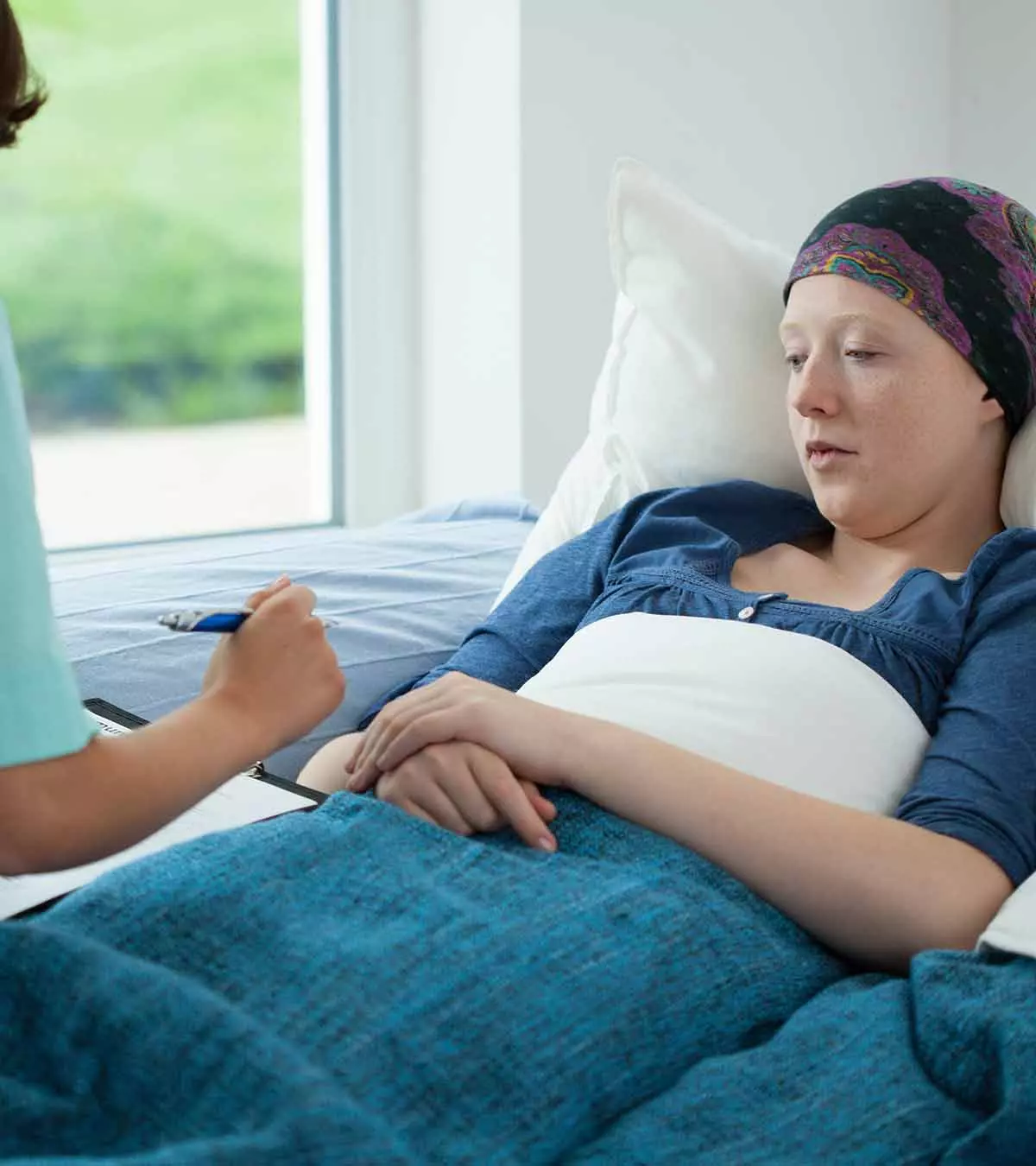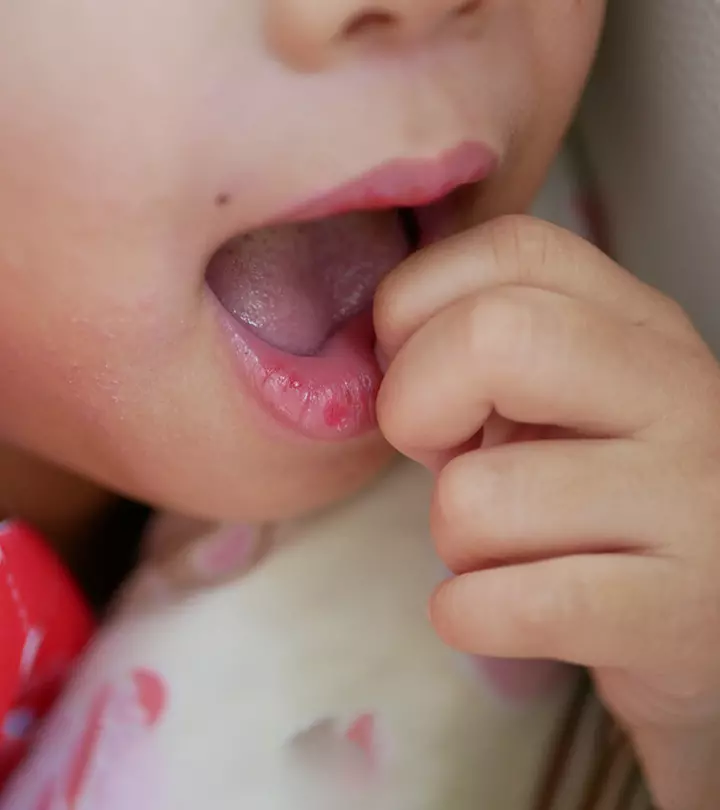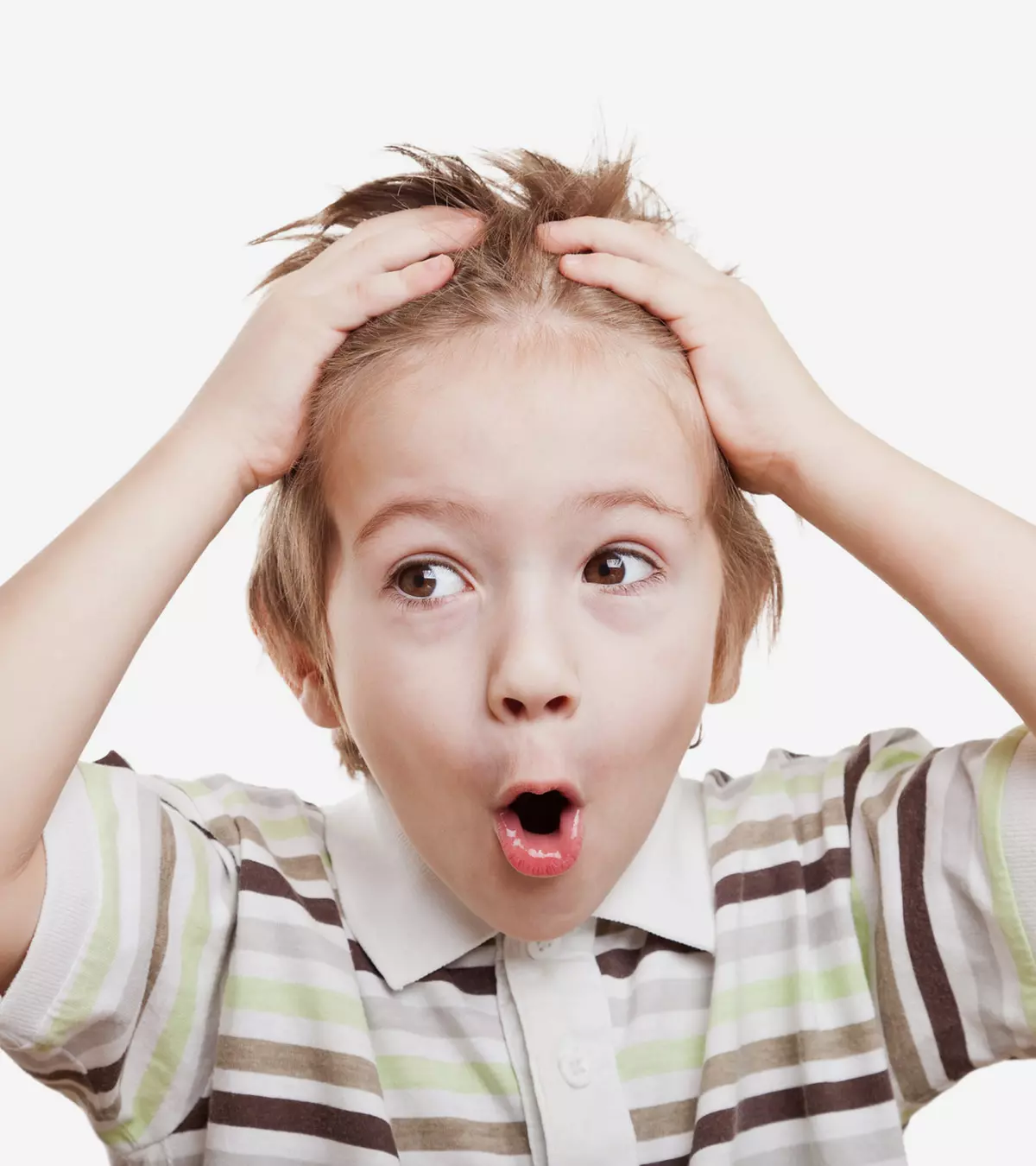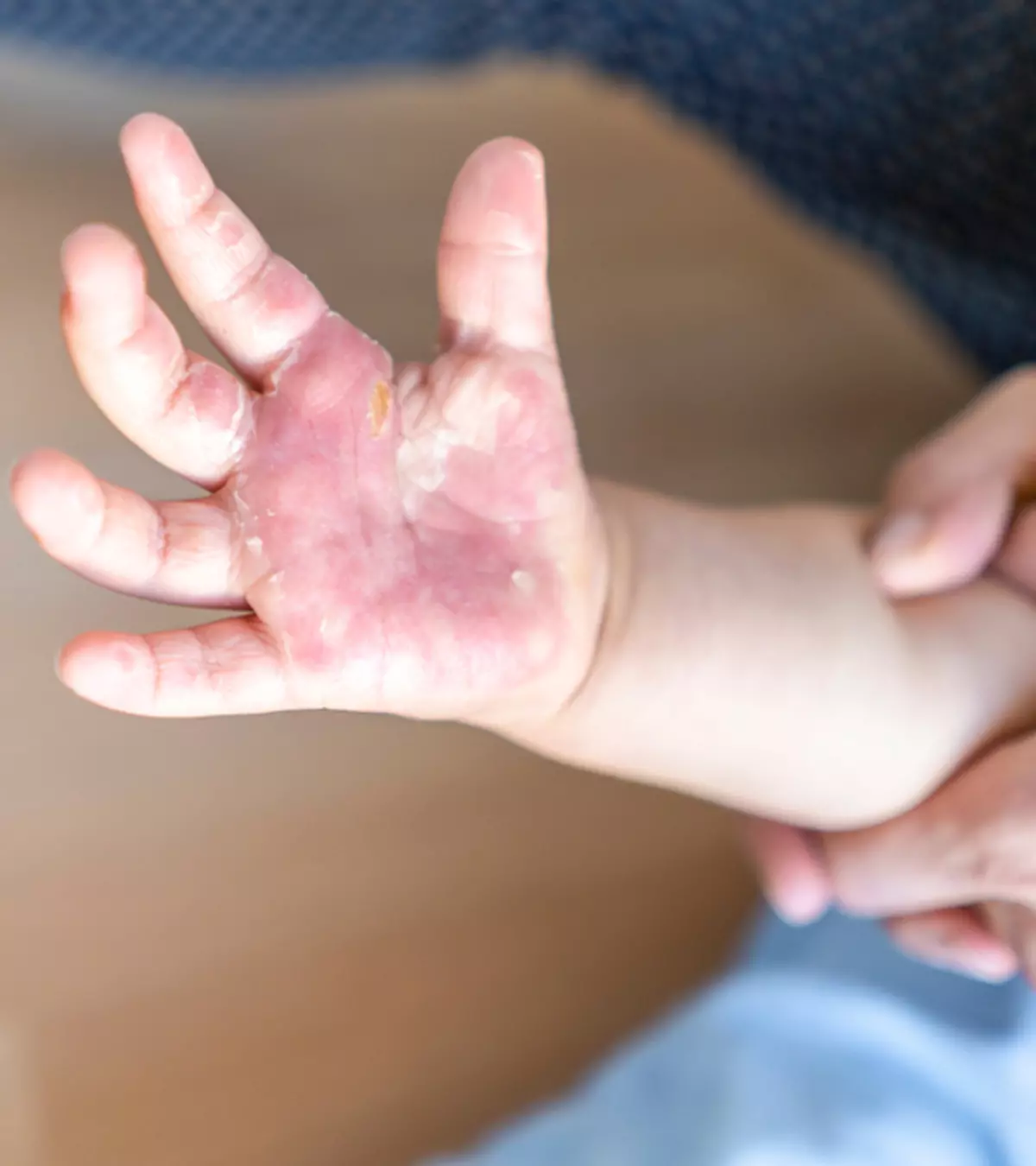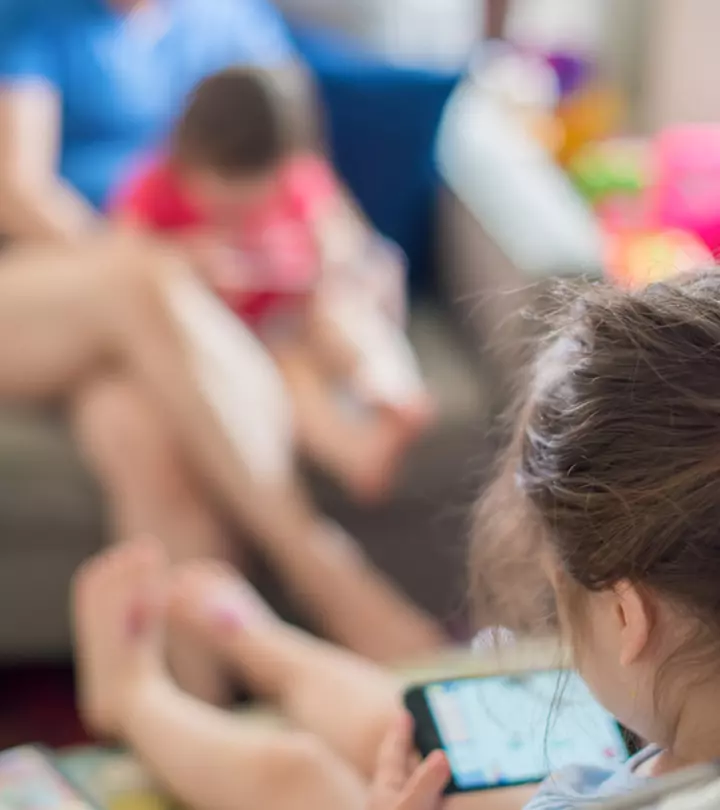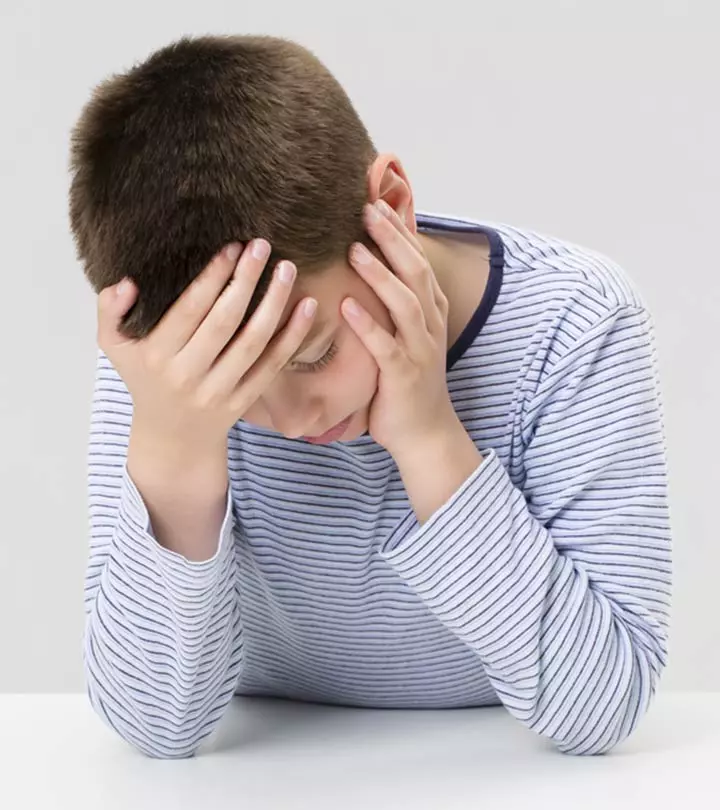
Image: Shutterstock
Headaches are quite common in children. About 20% of children aged five years and 75% of teenagers get occasional headaches (1). These occur due to stress, fatigue, poor eyesight, fever, lack of hydration, or allergies, such as a sinus infectioniAn infection where the tissue lining the air-filled spaces in the skull (sinus) gets inflamed (2). Headaches in children are mostly harmless and can be managed with simple coping strategies and home remedies.

Although rare, a persistent and acute headache can result from an underlying health condition that requires medical attention. Since children may not figure out the difference, you must be aware of the symptoms and consult a healthcare provider for proper diagnosis and treatment.
In this post, we will help you understand headaches in children, including their causes, symptoms, and treatment.
Key Pointers
- Children may frequently experience harmless headaches.
- Underlying medical issues may rarely cause chronic headaches in children.
- Headaches in children may be accompanied by nausea, sensitivity to light and sound, abdominal pain, and discomfort.
- Controlling headaches in children may involve nutritious diets, relaxation exercises, rest, massage, and the application of warm and cold compresses.
- The treatment of headaches may involve using OTC painkillers and vitamins, as well as addressing factors that trigger headaches.
Causes And Types Of Headaches In Children
It is believed that headaches occur due to muscle tightening and blood vessel dilation inside the head. Headaches have also been related to a change in the transmission of pain information from the head, face, and neck, between the nervous systems. Chronic headaches may result from poor or lack of sleep. Rarely, a headache can occur due to a problem, such as a brain tumor, or other abnormality.
Factors such as family history or genetics, stress, fatigue, sinusitis, ongoing medication, poor nutrition, or a head injury may also increase the risk of headaches in children (3) (4).
Headache in children is divided into two groups (5) (3):
- Primary headaches: Occasional and harmless, primary headaches are caused due to muscle tightening, blood vessel dilation, alteration of nerve pain signals, and swelling in different or specific parts of the brain. These headaches are not manifestations of an underlying health condition and are easily cured. The primary headaches are further divided into different types.
- Tension headaches: These result from stress and mental conflict. Inflicting mild pain, these are the most common headaches in children.
- Migraine headaches: Affecting about 20% of teenagers, migraine headaches can start as early as seven years in boys and ten years in girls. Children are likely to experience this type of headache if the family has a history of migraines. However, for girls, it may also be one of the symptoms of menstruation. Weakening and painful, migraines can persist for hours or even days for some children.

- Cluster headaches: Less common, cluster headaches are more frequently seen in teenage boys. Unlike tension headaches and migraine in teens, cluster headaches can continue for several weeks or months and seem to recur after every one or two years. Children are likely to get this type of headache from ten years of age.
- Secondary headaches: The rarest form of headaches, secondary headaches result from an underlying health condition such as brain abnormality or other health issues.Various factors can trigger secondary headaches, such as:
- Meningitis: It is a viral or bacterial infection that causes inflammation of the meninges, the protective layers around the brain and spinal cord. Headaches are often one of the first few symptoms of this infection (6).
- Encephalitis: Characterized by brain inflammation and swelling, encephalitis can also lead to headaches among its symptomatic expressions (7).
- Head Injury: Damage to the scalp, skull, brain, or associated tissues and blood vessels within the head constitutes a head injury. Headaches are a common symptom following such injuries (8).
Recognizing the diverse origins of secondary headaches plays a pivotal role in understanding and addressing the underlying health concerns associated with this uncommon form of headache.
Symptoms Of Headache In Children
The symptoms of headaches in children differ depending upon the type of headache they are experiencing (9):
Tension headaches
- Mild pain that develops slowly
- Pain on both sides of the head or surrounding the head
- Pain in the head or behind the neck
- Pain that impacts the child’s sleep pattern
Migraine headaches
- Nausea in children is often accompanied by vomiting
- Experiencing an aura, i.e., symptoms before the onset of a migraine, such as visions of flashing lights, or any change in the vision and sense of a foul smell
- Pulsating pain on one or both sides of the head
- Sound and light sensitivity
- Discomforts such as stomach pain
- Sweating
Cluster headaches
- Acute headache on either side of the head, usually around the eyes
- The affected eye most likely will be droopy, red, and have swollen eyelids
- Swollen forehead
- Nasal congestion
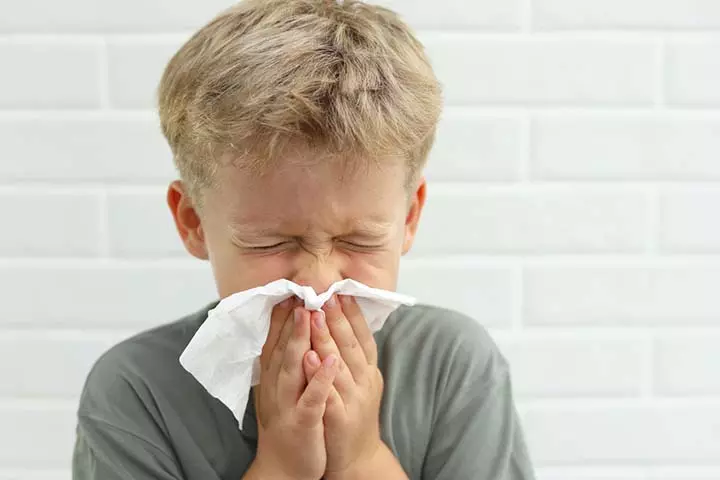
Secondary headaches
- Acute pain persisting for a long time
- Headache persisting from early morning
- Random or sudden pain
- Headache that worsens with time
- Compromised vision
- Headache with epilepsy or seizures
- Nausea with vomiting
Complications Of Headache In Children
A recurring and acute headache may cause a child to experience the following complications (9):
- Poor grades at school
- Behavioral issues
- Depression
Home Remedies For Headache In Children
Some home remedies to try for headache relief in children include (10) (11):
- Massage: Massaging the neck and shoulders can help release tension and thus relieve the pain. Older children may try some relaxation techniques such as deep breathing or progressive muscle relaxation technique that focuses on one muscle at a time and progressively releases the tension.

- Healthy diet: Intake of food, high in magnesium (promoter of healthy muscle state and muscle tension reliever), such as fish, yogurt, and spinach, can help prevent headaches. A balanced diet with minerals and vitamins, such as vitamin B2, can help cope with headaches.
- Essential oils: Essential oils including lavender, chamomile, or peppermint can be inhaled through aromatherapyiA healing treatment that uses aromatic materials such as massage oils, soaps, and lotions for pain relief. It works by acting on the brain’s limbic systemiCollection of structures involved in human behavioral and emotional responses that controls our behavioral and emotional responses. The essential oils can also be applied over the affected area in diluted form.
- Warm or cold compress: You can use an ice pack or a wet cloth as a cold compress and place it over the head. Warm cloth may also be used similarly.
Chronic daily headaches in children can be distressing and can disrupt their daily lives. However, knowing the difference between types of headaches can help to manage this condition. Learn more from the experts in this informative video.
When To See A Doctor
Consult with a healthcare provider in case (4) (5):
- The symptoms worsen with time
- The headaches start to impact your child’s daily activities, such as being unable to attend school or having problems while sleeping
- New symptoms begin to emerge
 Be watchful
Be watchfulDiagnosis Of Headache In Children
Diagnosis of a headache in children begins with assessing the symptoms and obtaining a complete medical history of the patient and the family. This is accomplished by asking the patient a few questions about (3) (9):
- Location of the headaches
- Intensity of pain
- Time of occurrence
- Nature of the pain
- Any specific activity that appears to trigger the pain
As parents, you may be asked if the child:
- Is showing any behavioral change
- Had past problems of emotional stress
- Had an accident involving head or face injuries
Maintaining a record or a headache symptoms diary with the occurrences, triggers, intensity, duration, location, and relieving factors may help with the diagnosis and the future headaches (2).
After evaluating the above factors, further tests may be carried out if a severe issue is detected.
- Blood test: It is carried out to check the levels of ferritiniA blood protein that stores iron , iron, and thyroid, along with blood count.
- MRI: This technique uses magnetic fields and radio waves to obtain an in-depth image of the inside organs or tissues of the body.
- CT scan: CT scan is an imaging modality that utilizes X-rays and computers to get a detailed picture of any body part such as bones, fats, different organs, and muscles.
- Polysomnogram: A procedure carried out during sleep, a polysomnogram monitors the patient’s breathing pattern and movement of the muscles. This is done to detect any form of sleep disorder.
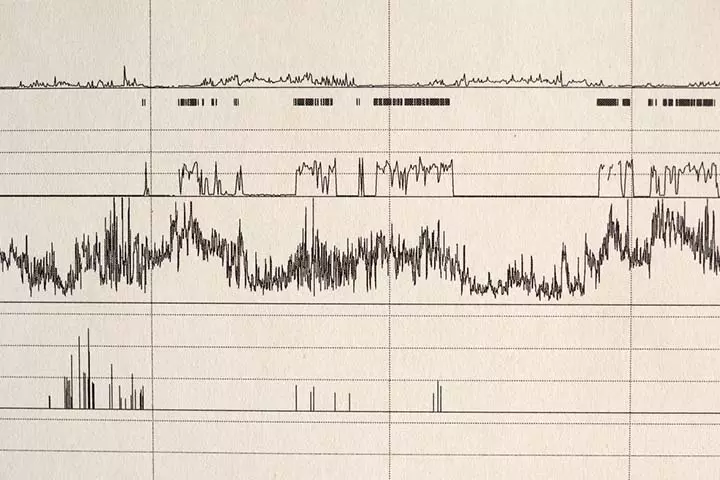
- Lumbar puncture (spinal tap): This test is carried out to measure the pressure of cerebrospinal fluid (CSF) to detect CSF infection, if any.
Treatment For Headache In Children
The treatment for headaches in children depends on the child’s age and the type, cause, and intensity of the headache (12) (13).
- Headache education: At times, there may be certain practices and even some foods that could trigger headaches. The treatment involves the doctor evaluating such factors and creating awareness among the patients regarding their possible triggers. These may be extreme stress, anxiety, lack of sleep, and food triggers such as caffeinated beverages, aged cheeses, and monosodium glutamate (MSG), to name a few.
- Abortive medicines: As the name suggests, abortive medicines help stop an ongoing headache by acting on specific blood vessel receptors in the head. These may include acetaminophen and ibuprofen.
- Rescue medicines: These refer to over-the-counter pain relief medicines such as acetaminophen, often used to treat headaches.
- Preventive medicines: Medications involved in preventive therapy are usually prescribed for acute migraine headaches. Certain vitamins, such as vitamin B2, and minerals, such as magnesium, have also been preventive against headaches.
- Behavioral management: This includes biofeedback techniques where children are taught to control their responses to cope with their pain. Behavioral management also involves certain relaxation therapies.
Prevention Of Headache In Children
Some simple preventive measures for headaches in children are (10):
- Ensure that your child gets plenty of rest to be stress-free.
- In case of stress, let them open up about their problems and talk to relieve some tension.
 Point to ponder
Point to ponder
- Make sure they have their meals on time and do not skip the important meals of the day.
- They should stay hydrated with plenty of water.
- Encourage them to exercise regularly to stay active and healthy.
- Ensure that they do not consume any food or drinks that can possibly trigger their headache.
Frequently Asked Questions
1. Can too much screen time cause headaches?
Yes, the glare from the screen lights can trigger migraine headaches in susceptible children. Moreover, too much screen time causes eye strain, and incorrect posture while viewing puts pressure on the back and the neck, leading to tension headaches and headaches in general (14).
2. Do children outgrow headaches?
Yes, children may outgrow their chronic headaches when they grow up or after about one to two years. However, a few may experience occasional migraine headaches (15).
3. How long do headaches in children last?
The duration of the headache is usually associated with the cause. If the headache is coupled with a viral illness, it may last anywhere between two and three days. In the case of unexplained headaches, they usually pass in a few hours or in rare cases they can last a day (16).
4. What vitamin deficiency causes headaches in children?
The deficiency of vitamin D is known to mimic a chronic tension headache in children (17).
If your child is experiencing a mild headache, do not be alarmed. Simple home remedies or prescribed medication can help alleviate the symptoms. However, consult a pediatrician or a neurologist to prevent an adverse outcome if you find severe symptoms.
Infographic: How To Manage Headaches In Children?
Headaches can greatly affect a child’s daily life, so parents and caregivers must know the right remedies. This infographic briefly explains effective management approaches for children’s headaches. It covers self-care techniques, medical interventions, and more, providing practical solutions to restore your child’s active and happy lifestyle.
Some thing wrong with infographic shortcode. please verify shortcode syntaxIllustration: Headaches In Children: Causes Symptoms Treatment And Prevention

Image: Stable Diffusion/MomJunction Design Team
References
- Headaches & migraines in children.
https://healthcare.utah.edu/pediatrics/programs-services/neurology/headache - Choon How How and Wei Shih Derrick Chan (2014). Headaches in children.
https://www.ncbi.nlm.nih.gov/pmc/articles/PMC4293983/ - Headaches in Children.
https://www.hopkinsmedicine.org/health/conditions-and-diseases/headache/headaches-in-children - Headaches in Children.
https://www.stanfordchildrens.org/en/topic/default?id=headaches-in-children-90-P02603 - Headaches in Children: When to Worry.
https://www.chop.edu/news/health-tip/headaches-in-children - Bacterial Meningitis in Children.
https://www.childrenshospital.org/conditions/bacterial-meningitis-children - Encephalitis in Children: Causes, Symptoms, Diagnosis and Treatment.
https://www.stlouischildrens.org/conditions-treatments/encephalitis - Head Injury in Children.
https://www.hopkinsmedicine.org/health/conditions-and-diseases/head-injury-in-children - Headaches in Children.
https://www.urmc.rochester.edu/encyclopedia/content?ContentTypeID=90&ContentID=P02603 - Natural Relief For Children Prone To Tension Headaches.
https://blog.nchs.org/natural-relief-for-children-prone-to-tension-headaches - Headaches in Children.
https://www.nationwidechildrens.org/conditions/headaches-in-children - Headaches in Children and Adolescents.
https://my.clevelandclinic.org/health/diseases/4225-headaches-in-children - Headache in Children.
https://www.mottchildren.org/conditions-treatments/pediatric-brain-neurological/pediatric-headache - Is Too Much Screen Time Causing Your Child’s Headaches?
https://cureheadaches.org/2025/11/04/is-too-much-screen-time-causing-your-childs-headaches/ - Can children outgrow chronic daily headaches?
https://www.eurekalert.org/news-releases/805701 - Headache
https://www.seattlechildrens.org/conditions/a-z/headache/#:~:text=Headaches%20are%20very%20common%20with,last%20up%20to%20a%20day - Sanjay Prakash et al. (2016). Vitamin D deficiency mimicking chronic tension-type headache in children
https://pubmed.ncbi.nlm.nih.gov/26838301/#:~:text=Vitamin%20D%20deficiency%20mimicking%20chronic%20tension%2Dtype%20headache%20in%20children
Community Experiences
Join the conversation and become a part of our nurturing community! Share your stories, experiences, and insights to connect with fellow parents.
Read full bio of Dr. Aldo Medina Serpa
Read full bio of Aneesha Amonz
Read full bio of Dr. Ritika Shah
Read full bio of Vidya Tadapatri






